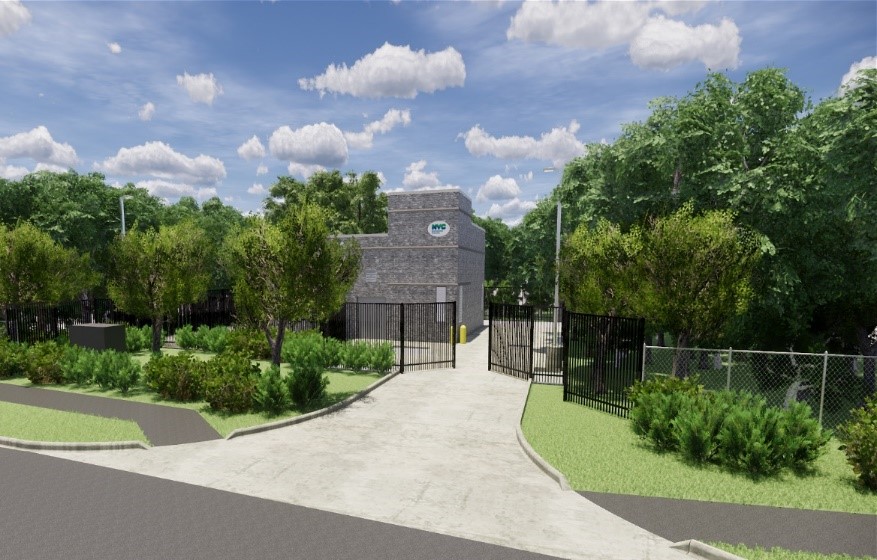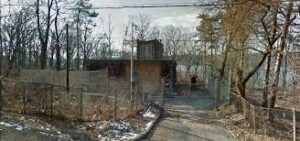On August 3, 2020, the Institute for Sustainable Infrastructure (ISI) announced that the New York City Department of Environmental Protection’s (DEP) $30 million reconstruction of the 235th Street Pumping Station (PS-313)—located in the Bronx borough of New York City—is the recent recipient of the Envision® Gold award for sustainable infrastructure.
The DEP worked in close collaboration with Tetra Tech to deliver this award-winning sustainable project. This project is the third DEP project to receive an Envision award, and the first to earn Gold. To earn Envision Gold, a project must demonstrate that it delivers a heightened range of environmental, social, and economic benefits to the host and affected communities.
“This project met several ambitious sustainability goals which were established at the outset of the project including reducing station energy requirements and greenhouse gas emissions, reducing potable water consumption and eliminating waste from operations and maintenance activities,” explained Melissa Peneycad, ISI’s Managing Director.
“The project team was able to achieve its sustainability goals largely due to the successful implementation of a comprehensive sustainability management system—one of the best examples of such a system we have evaluated as part of our project verification program. We are pleased to present the Envision Gold award for sustainable infrastructure to New York City’s Department of Environmental Protection and its project partners for the PS-313 project,” she added.
Project Context and Background
Originally constructed in 1966, the 235th Street Pumping Station is a combined sewage and stormwater pumping station located within Riverdale Park along Palisade Avenue in the Bronx. The pumping station handles a dry weather flow of 1.49 million gallons per day (MGD) and has a total station capacity of 10.9 MGD.
“Tetra Tech is pleased to have the opportunity to collaborate with the New York City DEP on this challenging and innovative project. The sustainable features of the upgraded facility integrate DEP’s system and culture of incorporating sustainable Envision certificate requirements into the planning, design and construction to achieve desired goals and provide indispensable operational, social and environmental benefits to residents,” said Joko Osinulu, P.E., PMP – Tetra Tech PS-313 Project Manager.
The 235th Street Pumping Station receives combined sewer flow from approximately 80 acres of sewershed and is the last in a series of three pump stations. This state of good repair project includes replacing the existing above grade pumping station building with a new building covering the same footprint as the existing building.
The foundation and subgrade structure will remain in place with concrete repairs performed on the structure and new equipment (pumps, valves, controls, etc.) installed. A new emergency generator will provide backup power for the station, therefore providing for continuous sewer service to the surrounding area even in times of emergency. A new 20-inch diameter force main from the pumping station will be constructed to provide more reliable service to the surrounding community, and the roadway will be repaired at the end of the project construction.
The primary goal of the PS-313 project is to design a safe, reliable, efficient, resilient, and low maintenance pumping station. In order to achieve this goal, sustainability has been a major focus for the project team since the early planning phases. The ISI Envision rating system was identified early on as an established framework that could guide the project team to meeting this goal, and therefore the team elected to pursue an Envision Gold verification.
“As an Accountable Manager with the PS-313 design team, it was a great experience to see the different facets of the Envision requirements being implemented throughout the design phase and coming together in the construction documents. For a pumping station rehabilitation, the goal was not only to make a better station for the Operators, but also to make a better station for the surrounding community and environment as a whole,” said Steve Elie-Pierre, P.E. – NYC DEP, PS-313 Accountable Manager.
The Envision sustainable infrastructure framework assesses project sustainability across five categories: Quality of Life, Leadership, Resource Allocation, Natural World, and Climate and Resilience. These key areas contribute to positive social, economic, and environmental impacts on a community during the
planning, design, and construction of infrastructure projects.
Key factors contributing to the PS-313 project’s earning an Envision Gold award:
Reducing Net Embodied Energy
Net embodied energy is the energy associated with the manufacturing of products and services. It is often considered ‘hidden’ energy, and, while the importance of accounting for and reducing embodied energy is gaining awareness, it remains an issue that is still too infrequently addressed by many infrastructure projects, but not the PS-313 project.
This project team set out to understand the embodied energy of the project, and to that end, completed a comprehensive life-cycle assessment in accordance with ISO (International Organization for Standardization) 14040 and 14044 standards for Environmental Management—Life Cycle Assessment. Using the results of the assessment, the project team was able to reduce net embodied energy by 10% by revising materials specifications for the project to include more energy-efficient alternatives.
Using Recycled and Regional Materials
One of the sustainability goals established for this project was to maximize the use of recycled and regionally sourced materials. The project team accomplished both of these objectives.
The overall recycled content for this project is approximately 83% by weight which was calculated by looking at recycled content percentages in materials specified for the project, as well as materials that will be reused on the project such as the existing concrete foundation for the station that will remain. In terms of regional materials, nearly 100% of materials used on this project are sourced locally (from within 50 to 500 miles depending on material type).
Managing Stormwater Runoff
For the PS-313 project, the team prepared a stormwater runoff reduction report which details the intended strategy to store and treat peak discharges of stormwater from the site. One of the main goals of this project is to increase on-site water storage capacity, and recharge groundwater supplies. Located on a
greyfield (previously developed site), this project has achieved a 90% improvement in water storage capacity.
Understanding Climate Change Risks and Preparing for Long-Term Adaptability
A Climate Risk Assessment and Adaptation Plan was prepared for this project. Climate related risks to the project which were comprehensively evaluated and accounted for in the project’s design include sea level rise, changing temperatures, an increase in the number and frequency of extreme weather events, and
reliability of energy sources.
To mitigate these issues and ensure the project is adaptable to withstand changing conditions, the design team included several measures reflecting sound engineering practices, including a complete back-up generator for the station which will provide 100% of the load to the entire station within the 24-hour fuel supply, and an enclosed maintenance location to preserve access to the site in the event of a storm surge. The new pump station replaces two existing pumps with four new pumps (including three duty pumps and one standby) to allow for more efficient operating scenarios and provide redundancy if one of the pumps is out of service. Additionally, this allows the pump station to adapt to future increases in flow by utilizing the fourth pump.
Minimizing Impact to Community Quality of Life and the Local Environment
One of the major challenges of this project was that the small physical size of the site and its location in the middle of a park limited design options for Envision credits. DEP attempted to leverage the concept of redeveloping the previous site to avoid new impacts as much as practical to minimize natural world
impacts.
In order to avoid impact to the surrounding wildlife preserve around the pumping station site, the roadway will be utilized for materials storage and laydown area during construction. This will result in closing the section of Palisade Avenue between 232nd Street and the approximately 300 feet north of the pumping station site to vehicular traffic. However, to minimize impacts to the surrounding community, the roadway will remain open to pedestrian traffic with a jersey barrier with construction fence atop separating pedestrian ways from the construction activity. This configuration maintains access to the wildlife preserve, which was identified as important to the quality of life of the nearby residents.
Images courtesy of New York City Department of Environmental Protection.


